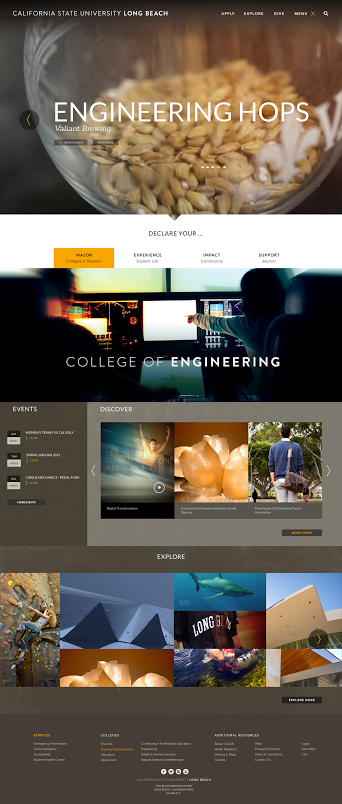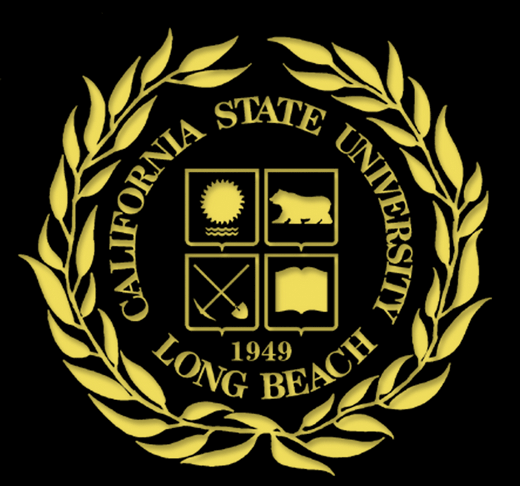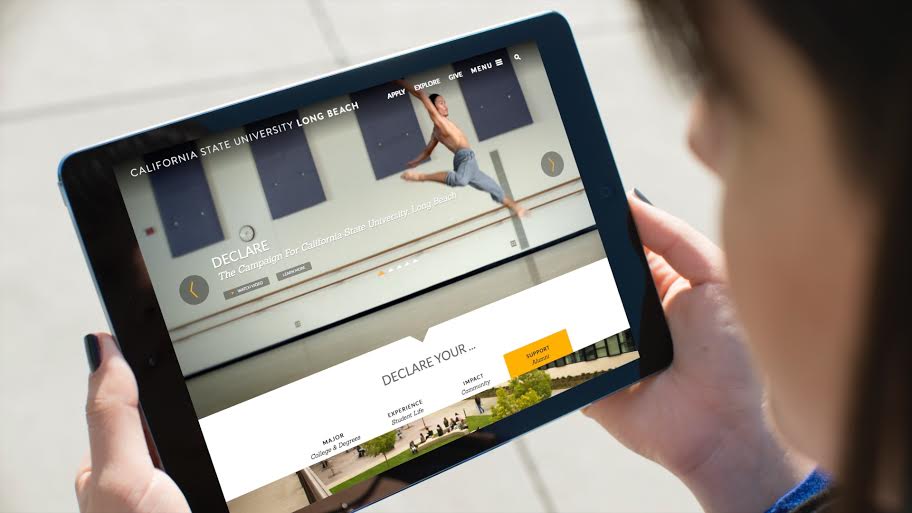 “In technology years, we’re about 30 years overdue,” said Andy Hoang, Associate Vice President of University Relations & Communications at California State University Long Beach, about the school’s old website.
“In technology years, we’re about 30 years overdue,” said Andy Hoang, Associate Vice President of University Relations & Communications at California State University Long Beach, about the school’s old website.
CSULB’s website hasn’t been redesigned in nearly 10 years. In terms of technology, according to Hoang, websites are usually refreshed or revitalized once every three years.
All that will change starting Wednesday, when CSULB’s new, modernized digital destination launches. The site will serve as the online public face of the campus—and by extension, the City of Long Beach—which will serve as an inviting digital presentation of all that the school and its Southern California home have to offer.
The new homepage is an entrancing introduction, a peek into the lives of a group of five alums and students whose stories are told through a series of short video compilations presented creatively to not only capture, but to hold the attention of prospective students, current students and community members. The stories automatically play when your browser first alights upon the page, and step away from the often austere, cut and dry, list-and-link-heavy higher education sites that cause so many prospective students to cringe with the mundanity of it all.
The new site was designed with form and function striding hand-in-hand, a necessity for CSULB’s 85,000 and counting applicants a year and its 35,000 current students.
“It’s supposed to be a place of resource,” Hoang relayed. “We have approximately 35,000 students and these students need to access email, or they need to access class schedules, and if they can’t navigate and get to that information quickly, then we’re not serving our students, we’re not doing our job well.”
One of the highest priorities with the new design involved building a site that its users could view on their mobile devices, one that is responsive to display on smartphone, tablet or desktop screens. According to Hoang, research shows that 90 percent of prospective and current students view websites, whether it be a higher education or any other type of website, on a mobile device.
“So if we don’t build a website that is responsive, that is responsive on a mobile device, you’re going to lose your audience, you’re going to lose your visitors,” he said.
 The new site was designed to tell students and prospective students the diverse and inspiring story of not only the University, but to the entire Long Beach community. The website will also serve as a bridge between the two entities, to better connect the school with the surrounding community, and to inform, or remind, non-students about all there is to enjoy about CSULB, such as the Japanese Garden, or attending a performance at The Carpenter Center.
The new site was designed to tell students and prospective students the diverse and inspiring story of not only the University, but to the entire Long Beach community. The website will also serve as a bridge between the two entities, to better connect the school with the surrounding community, and to inform, or remind, non-students about all there is to enjoy about CSULB, such as the Japanese Garden, or attending a performance at The Carpenter Center.
“What I also believe is that the prospective student or students, say in Arizona or Texas, who is looking for a Southern California experience, their first experience with Long Beach isn’t when they arrive, when they physically get to the university or get to to the city, their first experience is going to be when they log online,” Hoang explained. “That’s why I always say a website is a destination, a destination where you want it to mirror and feel what the experience is like if you were to be a member of the community, a member or a student.”
“In addition to that,” he continued, “while we’re trying to recruit students, we also want to become an employer of choice, we want to be one of the best places of employment. We want to hire, recruit, retain the most talented employees, because it’s that type of community that creates this wonderful experience for our students.”
One such facet of the site includes a new section called “Explore”, where the site’s 400 to 500 thousand unique visitors a month will be encouraged to see what they can do when they visit, whether they’re currently enrolled or not. A new “Resources” section will meet the needs of current students, staff and faculty, while the new “Declare” section will encourage users to “declare” not only their majors, but their impact on the community, their support for their alma mater and their student life experience. A new “Discover” section will showcase news, such as faculty research projects and other campus-born stories.
Along with the new Shark Lab, University Art Museum, and 49er Bookstore homepages, the site will also have a new language feature, allowing users to view the homepage and several other pages in 91 different languages, a true reflection of the diversity on campus.
“We have the largest Cambodian student population in the country and now our Cambodian audience will be able to view parts of the home page in Cambodian,” said Hoang proudly.
Tying it all together is a new menu, worded and grouped with the utmost care—a tedious, selective process involving minute decisions between such factors as the terms “admissions” versus “enrollment services.” Hoang says subtle differences such as word choice can make the lives of students and other users that much easier.
As far as who designed the brand new site, CSULB used the talent they had on-hand, leveraging the skills of designers in-house, and soliciting input from faculty, staff, students and alumni.
“I smile because you would think that we went out and retained an agency, a well known design agency to come up with the vision, the strategy, the design and then build it, but it wasn’t,” said Hoang with a grin. “It was our senior designer, named Jorge Hurtado, who’s actually an alum, he’s been an employee here for 15 years, and myself, who came up with the vision, the strategy, and then began building it.”
The new design is minimalist throughout, a style more easily described than actually achieved. The site now stands as a modern, yet timeless showcase that is “future-proof,” according to Huong, who explained that the underlying structure of the site is built to grow with the University’s and community’s needs.
 Drupal, an open source Content Management System (CMS)—also used by six other CSUs—will enable CSULB to update the site seamlessly with new features and programming constantly being designed by the CMS’s team of developers. The site will be hosted on a cloud server by Acquia, a company owned by the creator of Drupal, that will ensure the scalability of the site, its security and reliability, empowering the CSULB team to focus on the message they want to send to their students and community, instead of having to worry about the site’s technical needs.
Drupal, an open source Content Management System (CMS)—also used by six other CSUs—will enable CSULB to update the site seamlessly with new features and programming constantly being designed by the CMS’s team of developers. The site will be hosted on a cloud server by Acquia, a company owned by the creator of Drupal, that will ensure the scalability of the site, its security and reliability, empowering the CSULB team to focus on the message they want to send to their students and community, instead of having to worry about the site’s technical needs.
The entire website has 30,000 pages, said Hoang, meaning Wednesday will mark the introduction of several key features of the new site, while some of the links will still direct users toward the old pages, or the “legacy site,” as CSULB now calls the old design. This is just the first phase of many to come, says Hoang.
“I’m excited about the launch of our new website and proud of the teams and individuals across campus whose dedication and vision brought it to life,” said CSULB President Jane Close Conoley. “Dynamic, mobile-friendly and intuitive, it will immediately engage users—prospective and current students, faculty, staff, alumni and community partners—and raise awareness of our innovative programs, academic resources and services. As the first experience many people have of The Beach, it reflects our excellence. Oh, and did I say beautiful? It is beautiful.”
“The University website has a huge impact on the community at large,” said Hoang. “I believe that the City wouldn’t be this City without this University, and vice versa. We compliment each other so much, you see all the cool things in the City, it’s happening right here, it’s been happening right here, we just haven’t quite told that story, yet.”

